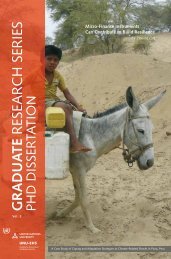Unveiling Women as Pillars of Peace Peace Building in ...
Unveiling Women as Pillars of Peace Peace Building in ...
Unveiling Women as Pillars of Peace Peace Building in ...
Create successful ePaper yourself
Turn your PDF publications into a flip-book with our unique Google optimized e-Paper software.
Western Prov<strong>in</strong>ce. After the election, cl<strong>as</strong>hes <strong>in</strong>tensified and kept recurr<strong>in</strong>g on a small scale at<br />
different times, <strong>in</strong> various places through 1995. As the next elections approached, the country<br />
witnessed a resurgence <strong>of</strong> conflicts start<strong>in</strong>g <strong>in</strong> 1996. In August 1997, Momb<strong>as</strong>a, unaffected by<br />
earlier conflicts, entered the circus <strong>of</strong> violence.<br />
Some analysts attribute these ethnic cl<strong>as</strong>hes <strong>in</strong> Kenya to <strong>in</strong>cre<strong>as</strong>ed competition for<br />
shr<strong>in</strong>k<strong>in</strong>g resources, particularly land (Rogge 1993). However, this <strong>in</strong>terpretation does not expla<strong>in</strong><br />
why the cl<strong>as</strong>hes erupted <strong>in</strong> 1991, why they followed a pattern <strong>of</strong> occurr<strong>in</strong>g <strong>in</strong> ethnically<br />
heterogeneous zones, and more significantly, why the state w<strong>as</strong> reluctant to deal firmly with the<br />
perpetrators <strong>of</strong> violence. Commissioned by UNDP the Rogge (1993) report takes an <strong>in</strong>stitutional<br />
view and does not focus on communities or mention the role <strong>of</strong> women <strong>in</strong> the restoration <strong>of</strong> peace.<br />
Other analysts look to the role <strong>of</strong> the state <strong>in</strong> democratisation and open<strong>in</strong>g the political<br />
arena <strong>in</strong> the 1990s, particularly with the repeal <strong>of</strong> Section 2(a) <strong>of</strong> the constitution which made<br />
Kenya de jure a one party state <strong>in</strong> 1982. Repeal allowed other parties and different political<br />
articulations that challenged the Kenya African National Union (KANU), whose power w<strong>as</strong><br />
beg<strong>in</strong>n<strong>in</strong>g to erode. The KANU rul<strong>in</strong>g clique w<strong>as</strong> une<strong>as</strong>y over the prospect <strong>of</strong> los<strong>in</strong>g the second<br />
multiparty election s<strong>in</strong>ce <strong>in</strong>dependence. To ensure victory, they created zones <strong>of</strong> support that<br />
paralleled ethnic configurations. The ethnic zones were designed to isolate populations perceived<br />
<strong>as</strong> supportive <strong>of</strong> opposition parties. For the state, such communities, def<strong>in</strong>ed <strong>in</strong> ethnic terms, were<br />
perceived <strong>as</strong> enemy populations <strong>of</strong> doubtful allegiance, whose political actions would be difficult<br />
to control.<br />
The nexus between ethnicity and geographical space gave the 1990s cl<strong>as</strong>hes their unique<br />
character. The campaign aga<strong>in</strong>st multiparty politics would have had a less violent impact, were it<br />
not for this <strong>as</strong>sociation (Somjee and Kath<strong>in</strong>a). These cl<strong>as</strong>hes were attempts to drive away<br />
populations seen <strong>as</strong> “alien” (non-<strong>in</strong>digenous) <strong>in</strong> a bid to create ethnic homogeneity, presumed to<br />
operate <strong>as</strong> bloc that could <strong>of</strong>fer political support. As “enemy” communities were expunged,<br />
KANU strongmen urged vigilantes to create and protect KANU zones. For example, <strong>in</strong> early<br />
1991, the controversial majimbo 8 rallies promulgated the theory that the Rift Valley w<strong>as</strong> an<br />
exclusive Kalenj<strong>in</strong> KANU zone. Opposition party leaders were warned not to enter the Rift<br />
Valley. Meanwhile, their presumed supporters were be<strong>in</strong>g driven out <strong>of</strong> the Rift Valley (Kath<strong>in</strong>a<br />
and M<strong>as</strong>ika 1997:9, Kiliku et al 1992). It is this <strong>as</strong>pect <strong>of</strong> the cl<strong>as</strong>hes that Peter Kagwanja (1998)<br />
labels state-sponsored violence.<br />
Ironically, the relationship between ethnicity and territory is rooted <strong>in</strong> colonial policies<br />
that created the enviable “white” highlands. Dur<strong>in</strong>g this period, Kenyans were evicted to create<br />
space for settler agriculture. With <strong>in</strong>dependence, the pr<strong>in</strong>ciple <strong>of</strong> “will<strong>in</strong>g seller, will<strong>in</strong>g buyer”<br />
determ<strong>in</strong>ed who could own these lands. People <strong>of</strong> different ethnic backgrounds, with the ability to<br />
purch<strong>as</strong>e these farms, either <strong>in</strong>dividually or <strong>as</strong> members <strong>of</strong> co-operatives, became neighbours.<br />
Meanwhile, large numbers <strong>of</strong> people who had been evicted earlier, but did not have money after<br />
<strong>in</strong>dependence, rema<strong>in</strong>ed squatters. The are<strong>as</strong> that witnessed the most violent <strong>of</strong> <strong>in</strong>ter-ethnic<br />
cl<strong>as</strong>hes were with<strong>in</strong> the former “white” highlands. 9 The pr<strong>in</strong>cipal are<strong>as</strong> <strong>of</strong> conflict <strong>in</strong>clude (1) the<br />
Rift Valley districts <strong>of</strong> Nakuru, Molo, Kericho, Nandi, U<strong>as</strong><strong>in</strong> Gishu, Trans-Mara, and Marakwet;<br />
(2) the districts that flank Mt. Elgon, namely, Trans-Nzoia, Bungoma and Mt. Elgon, and (3)<br />
Momb<strong>as</strong>a located <strong>in</strong> the Co<strong>as</strong>t Prov<strong>in</strong>ce.<br />
Intra-Ethnic Cl<strong>as</strong>hes<br />
Incre<strong>as</strong><strong>in</strong>gly, <strong>in</strong>ter ethnic cl<strong>as</strong>hes are occurr<strong>in</strong>g simultaneously with <strong>in</strong>tra ethnic cl<strong>as</strong>hes.<br />
Marakwet, Elgeyo and Pokot districts are witness<strong>in</strong>g repeated waves <strong>of</strong> <strong>in</strong>ter-communal violence<br />
13



